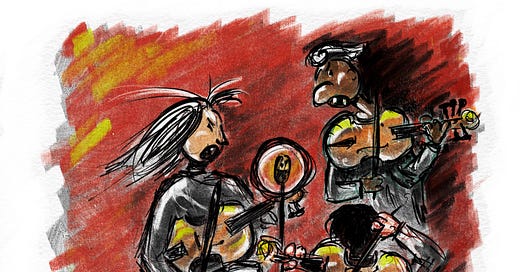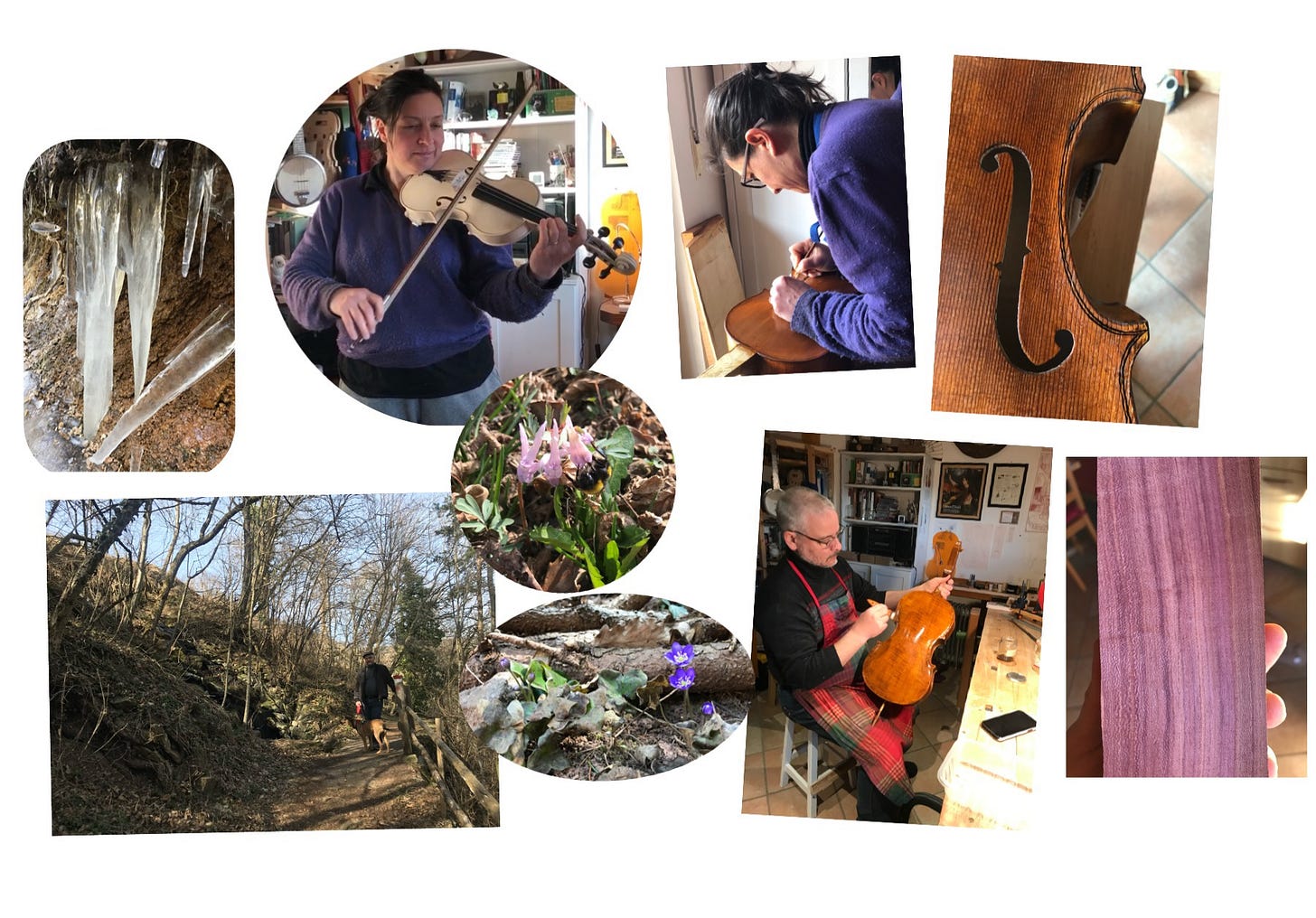It’s generally accepted that a small cello with either five or four strings (in the latter case tuned G2 D3 A3 E4, that is, one octave below violin) was popular in Veneto (northern Italy), Austria, Bavaria and Bohemia during the whole 18th century. Thus, music collections of this period and places are good mines for us. Well-known authors such as Caldara, Benedetto Marcello, Bononcini, or even Vivaldi and Tartini published works “for cello” that, due to wide and virtuosic use of the high range of the instruments, fit so well on our five strings da spalla. So well, actually, that in some cases, they may well have been written with a little five-stringed cello in mind.
Personally, I like to approach an instrument using the didactic sources of the period.
At this link below:
https://digital.onb.ac.at/RepViewer/viewer.faces?doc=DTL_8835088
you can find 44 short pieces by Antonio Caldara. They are didactical studies for cello and basso, which explore the whole range of a GDAE instrument, remaining in a comfortable first position.
In another manuscript of the same provenience, there is a Sinfonia a Violoncello solo by the same Antonio Caldara, which is, in fact, a sonata for violoncello and continuo. Here is the link:
https://digital.onb.ac.at/RepViewer/viewer.faces?doc=DTL_7358560&order=1&view=SINGLE
It comprises only the high register of the instrument, you don’t even need a G string for it. That is, we can play it without using at all double wound strings! Or, in other words, a solo player could avoid worrying if his bass strings were not performing so well! As the 44 short pieces above, it is all comfortable in the first position.
Antonio Caldara (1670-1736) was a famous composer (mainly of opera and vocal music) and cellist, born in Venice and son of a violinist. He figures in the book of musicians paid in San Marco as viola da Spalla as well as violonzino and contralto. Later, in Prague, he collaborated with Tartini and Vandini.
His main collection of instrumental music is in the castle of Wiesentheid, the 16 sonatas for cello and basso. That work is just the jewel on top of a vast music collection, formed by a nobleman amateur cellist, count Rudolf Franz Erwin von Schönborn-Wiesentheid, who commissioned cello music to many Italian composers of the first half of the 18th century like Vivaldi, Platti, Zani and many others. His collection is today the most important source of baroque cello music.
The manuscripts in the two links above, instead, are from the estense (from Este family) collection in Wien, so they probably come from the collection of music of another nobleman amateur cellist, Nicolò Sanguinazzo, from Padova (same period of count Schönborn’s). The entire collection (music, manuscripts and instruments) was acquired by Conte Obizzi and later transferred to the Augsburg art collection, which is now in Wien.
,
These two noblemen have in common the passion for cello, the fact that they commissioned music which they could play, and they both owned various sizes of cellos: big tuned in C, small tuned in G, and Schönborn also owned a five strings cello.
Sanguinazzo was also a violinist and a composer, who defined himself “dilettante di violoncello” (amateur cellist): it is peculiar that his compositions are sometimes in three versions: violin, cello and tenor, and the three instrument parts have the precise same fingering pattern. The sonatas for tenor do not go below G string. The music he commissioned was for violin or for cello GDAE. May we hypothesise that he played that small cello as da Spalla?
Considering that music was printed without specifying a precise destination of instruments and was thus played with those available, exactly in the same way an instrument was played with the technique “available,” both of these two music collections are for us a precious gold mine repertoire.
News from da Spalla world
This was a quiet week, and I haven't much to report on this section.
If you know of any event in which a violoncino da spalla is being featured, or you are hosting such an event and you want to be featured here, please write us here, on Facebook, or through our website, which is www.violoncellodaspalla.it
Updates from our workshop
A quiet week even here at our workshop in Meltina, which is in South Tyrol, at the very north of Italy. Spring is finally showing up, ice is melting, and the first flowers are blooming. It has been a long winter, and we need to get out and regain our shape!
We are very happy with the sound of Alessandro’s violin in white, and we are getting on with the finishing of the Wagner. I painted purflings on the top (and I don’t think I will ever want to do it again!), and I started making the fingerboard and tailpiece. The original has them made out of prune wood, and I have found this gorgeous prune at Rivolta. It’s hard and light and has a pleasant scent.
Featured video of the week
In this video Koji Otsuki plays a Sonata a 3 by Purcell, his own arrangement. The voice of his cello da spalla covers with ease the alto and the tenor range, the perfect instrument for a sonata a 3.








Anything written for the Violin can also be played on the Violoncello da Spalla, the only difference is that it'll sound an Octave lower than written.